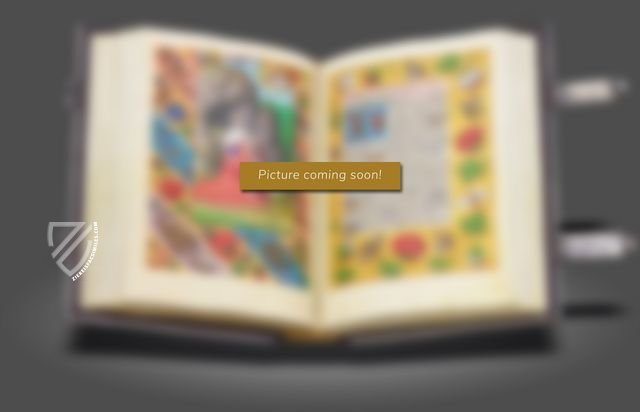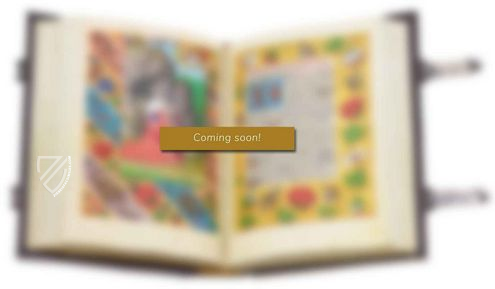Works of Geoffrey Chaucer and the Kingis Quair
(under 1,000€)
The last great manuscript anthology of Geoffrey Chaucer’s works is also one of the earliest Scottish literary anthologies. MS Arch. Selden. B. 24 of the Bodleian Library contains texts of Troilus and Criseyde, the Legend of Good Women, and the Parliament of Fowls along with various shorter works by Chaucer. It also contains the Quare of Jelusy * and the *Kingis Quair by King James I of Scotland, one of the oldest Scottish works written in the courtly style and thus offers substantial evidence of how Chaucer was received in Scotland. The history of how the manuscript was created is complex and offers important insights into how such anthologies were compiled.
Works of Geoffrey Chaucer and the Kingis Quair
Among the various anthologies of the works of Geoffrey Chaucer (1342/43–1400), this manuscript is a unique example of a particularly rich and diverse “household book” that is solely devoted to Chaucer and was created in various stages beginning ca. 1489. Despite the association of Chaucer with London literary culture and the authority of the English language, this is a Scottish manuscript that includes a poem by inter alia King James I of Scotland (1394–1437) and was commissioned by a wealthy Scottish family with a unique taste for all things Chaucer.
A Curious Work Created in Stages
This Chaucerian collection began with an unadorned copy of Troilus and Criseyde, which was appended with a diverse assortment of poems, some by Chaucer and others incorrectly attributed to him, perhaps as a means of “Scotticizing” him: Truth, the Complaint of the Black Knight by John Lydgate (ca. 1370 – ca. 1451), Mother of Gods by Thomas Hoccleve (1368/69–1426), the Complaint of Mars and Complaint of Venus, the Book of Cupid by Sir John Clanvowe (ca. 1341–91), the Parliament of Fowls, and the Legend of Good Women. It ends with King James’ Kingis Quair, which the scribe treated with the same respect as Chaucer’s own work. At this point, it is obvious that a second scribe has taken up the work and added four more works including Hoccleve’s Letter of Cupid three Scottish works: the Lay of Sorrow, the Lufaris Complaynt, and the Quare of Jelusy. Finally, shorter unattributed poems in a Scottish dialect were written on what was originally the manuscript’s flyleaves and added by a much later third hand.
Provenance of the Manuscript
The décor of the manuscript was not part of the original design and appears to have been added sometime before the second scribe made his contributions but sheds some light on its origins. Its lavish opening folio with a historiated initial is one of the few illustrations of a scene of Troilus and Criseyde. This folio was actually a replacement of the original but was created by the same scribe. The Sinclair family coat of arms that appears on fol. 118v may even predate this “upgrade” and indicates that the Sinclairs either commissioned the original manuscript or acquired and expanded it shortly after it originated. Various decorative initials and borders with flowers, fruits, songbirds, and an owl were added at a later date. What is known for certain is that the manuscript was owned by the English polymath John Selden (1584–1654) before being acquired by Oxford’s Bodleian Library in 1659 and remains there today.
A Poem of Royal Captivitiy
The Kingis Quair was composed in the Chaucerian rhyme scheme rhyme royal (ABABBCC) as a narrative of King James’ captivity by the three Lancastrian Kings of England Henry IV, Henry V, and Henry VI between 1406 and 1424. It describes his capture at sea while on his way to France and his subsequent imprisonment. After a period of isolation, a songbird helps to lift his spirit and when looking outside, he sees a beautiful woman and falls in love. She is eventually able to liberate him and represents Joan Beaufort (ca. 1404–45), whom James married as part of an agreement for his release that created an alliance with England instead of France. Falling into a depression after she leaves, he is visited in a dream by the goddesses Venus, Minerva, and Fortune. After having been instructed on the nature of free will and endowed with wisdom, he is reunited with his beloved and gives thanks to all who helped him, including a dedication to Chaucer and John Gower (ca. 1330–1408).
Codicology
- Alternative Titles
- Werke von Geoffrey Chaucer und das Kingis Quair
- Type
- Manuscript on paper
- Origin
- United Kingdom
- Date
- Ca. 1489
- Epochs
- Style
- Genre
- Language
- Script
- Late gothic secretary
- Content
- Troilus and Criseyde by Geoffrey Chaucer; poems by Geoffrey Chaucer, Thomas Hoccleve and John Lydgate; The Kingis Quair by James I of Scotland
- Artist / School
- Geoffrey Chaucer (author)
Thomas Hoccleve (author)
John Lydgate (author)
James I of Scotland (author) - Previous Owners
- John Selden
#1 The Works of Geoffrey Chaucer and the Kingis Quair: a Facsimile of Bodleian Library, Oxford, MS Arch. Selden. B. 24
Language: English
(under 1,000€)
- Treatises / Secular Books
- Apocalypses / Beatus
- Astronomy / Astrology
- Bestiaries
- Bibles / Gospels
- Chronicles / History / Law
- Geography / Maps
- Saints' Lives
- Islam / Oriental
- Judaism / Hebrew
- Single Leaf Collections
- Leonardo da Vinci
- Literature / Poetry
- Liturgical Manuscripts
- Medicine / Botany / Alchemy
- Music
- Mythology / Prophecies
- Psalters
- Other Religious Books
- Games / Hunting
- Private Devotion Books
- Other Genres
- Afghanistan
- Armenia
- Austria
- Belgium
- Colombia
- Croatia
- Cyprus
- Czech Republic
- Denmark
- Egypt
- Ethiopia
- France
- Germany
- Greece
- Hungary
- India
- Iran
- Iraq
- Israel
- Italy
- Japan
- Lebanon
- Luxembourg
- Mexico
- Morocco
- Netherlands
- Palestine
- Peru
- Poland
- Portugal
- Russia
- Serbia
- Spain
- Sri Lanka
- Sweden
- Switzerland
- Syria
- Turkey
- Ukraine
- United Kingdom
- United States
- Uzbekistan
- Aboca Museum
- Ajuntament de Valencia
- Akademie Verlag
- Akademische Druck- u. Verlagsanstalt (ADEVA)
- Aldo Ausilio Editore - Bottega d’Erasmo
- Alecto Historical Editions
- Alkuin Verlag
- Almqvist & Wiksell
- Amilcare Pizzi
- Andreas & Andreas Verlagsbuchhandlung
- Archa 90
- Archiv Verlag
- Archivi Edizioni
- Arnold Verlag
- ARS
- Ars Magna
- ArtCodex
- AyN Ediciones
- Azimuth Editions
- Badenia Verlag
- Bärenreiter-Verlag
- Belser Verlag
- Belser Verlag / WK Wertkontor
- Benziger Verlag
- Bernardinum Wydawnictwo
- BiblioGemma
- Biblioteca Apostolica Vaticana (Vaticanstadt, Vaticanstadt)
- Bibliotheca Palatina Faksimile Verlag
- Bibliotheca Rara
- Boydell & Brewer
- Bramante Edizioni
- Bredius Genootschap
- Brepols Publishers
- British Library
- C. Weckesser
- Caixa Catalunya
- Canesi
- CAPSA, Ars Scriptoria
- Caratzas Brothers, Publishers
- Carus Verlag
- Casamassima Libri
- Chavane Verlag
- Christian Brandstätter Verlag
- Circulo Cientifico
- Club Bibliófilo Versol
- Club du Livre
- CM Editores
- Collegium Graphicum
- Collezione Apocrifa Da Vinci
- Comissão Nacional para as Comemorações dos Descobrimentos Portugueses
- Coron Verlag
- Corvina
- CTHS
- D. S. Brewer
- Damon
- De Agostini/UTET
- De Nederlandsche Boekhandel
- De Schutter
- Deuschle & Stemmle
- Deutscher Verlag für Kunstwissenschaft
- DIAMM
- Droz
- E. Schreiber Graphische Kunstanstalten
- Ediciones Boreal
- Ediciones Grial
- Ediclube
- Edições Inapa
- Edilan
- Editalia
- Edition Deuschle
- Edition Georg Popp
- Edition Leipzig
- Edition Libri Illustri
- Editiones Reales Sitios S. L.
- Éditions de l'Oiseau Lyre
- Editions Medicina Rara
- Editorial Casariego
- Editorial Mintzoa
- Editrice Antenore
- Editrice Velar
- Edizioni Edison
- Egeria, S.L.
- Eikon Editores
- Electa
- Emery Walker Limited
- Enciclopèdia Catalana
- Eos-Verlag
- Ephesus Publishing
- Ernst Battenberg
- Eugrammia Press
- Extraordinary Editions
- Fackelverlag
- Facsimila Art & Edition
- Facsimile Editions Ltd.
- Facsimilia Art & Edition Ebert KG
- Faksimile Verlag
- Feuermann Verlag
- Folger Shakespeare Library
- Franco Cosimo Panini Editore
- Friedrich Wittig Verlag
- Fundación Hullera Vasco-Leonesa
- G. Braziller
- Gabriele Mazzotta Editore
- Gebr. Mann Verlag
- Gesellschaft für graphische Industrie
- Getty Research Institute
- Giovanni Domenico de Rossi
- Giunti Editore
- Graffiti
- Grafica European Center of Fine Arts
- Guido Pressler
- Guillermo Blazquez
- Gustav Kiepenheuer
- H. N. Abrams
- Harrassowitz
- Helikon
- Hendrickson Publishers
- Henning Oppermann
- Herder Verlag
- Hes & De Graaf Publishers
- Hoepli
- Holbein-Verlag
- Hortus Deliciarum
- Houghton Library
- Hugo Schmidt Verlag
- Idion Verlag
- Il Bulino, edizioni d'arte
- ILte
- Imago
- Insel Verlag
- Instituto Nacional de Antropología e Historia
- Istituto dell'Enciclopedia Italiana - Treccani
- Istituto Ellenico di Studi Bizantini e Postbizantini
- Istituto Geografico De Agostini
- Istituto Poligrafico e Zecca dello Stato
- Italarte Art Establishments
- J. Thorbecke
- Jan Thorbecke Verlag
- Johnson Reprint Corporation
- Josef Stocker
- Josef Stocker-Schmid
- Jugoslavija
- Karl W. Hiersemann
- Kasper Straube
- Kaydeda Ediciones
- Kindler Verlag / Coron Verlag
- Kodansha International Ltd.
- Konrad Kölbl Verlag
- Kurt Wolff Verlag
- La Liberia dello Stato
- La Linea Editrice
- La Meta Editore
- Lambert Schneider
- Landeskreditbank Baden-Württemberg
- Leo S. Olschki
- Les Incunables
- Library of Congress
- Libreria Musicale Italiana
- Lichtdruck
- Lito Immagine Editore
- Lumen Artis
- Lund Humphries
- M. Moleiro Editor
- Maison des Sciences de l'homme et de la société de Poitiers
- Manuscriptum
- Martinus Nijhoff
- Maruzen-Yushodo Co. Ltd.
- MASA
- McGraw-Hill
- Militos
- Millennium Liber
- Müller & Schindler
- Nahar and Steimatzky
- National Library of Wales
- Neri Pozza
- Nova Charta
- Oceanum Verlag
- Odeon
- Orbis Mediaevalis
- Orbis Pictus
- Österreichische Staatsdruckerei
- Oxford University Press
- Pageant Books
- Parzellers Buchverlag
- Patrimonio Ediciones
- Pattloch Verlag
- PIAF
- Pieper Verlag
- Plon-Nourrit et cie
- Prestel Verlag
- Princeton University Press
- Prisma Verlag
- Priuli & Verlucca, editori
- Pro Sport Verlag
- Propyläen Verlag
- Pytheas Books
- Quaternio Verlag Luzern
- Reales Sitios
- Recht-Verlag
- Reichert Verlag
- Reichsdruckerei
- Riehn & Reusch
- Roberto Vattori Editore
- Rosenkilde and Bagger
- Roxburghe Club
- Salerno Editrice
- Sarajevo Svjetlost
- Schöck ArtPrint Kft.
- Scolar Press
- Scrinium
- Scripta Maneant
- Scriptorium
- Siloé, arte y bibliofilia
- SISMEL - Edizioni del Galluzzo
- Sociedad Mexicana de Antropología
- Société des Bibliophiles & Iconophiles de Belgique
- Soncin Publishing
- Sorli Ediciones
- Stainer and Bell
- Studer
- Styria Verlag
- Sumptibus Pragopress
- Szegedi Tudomànyegyetem
- Taberna Libraria
- Tarshish Books
- Taschen
- Tempus Libri
- Testimonio Compañía Editorial
- Thames and Hudson
- The Clear Vue Publishing Partnership Limited
- The Facsimile Codex
- The Folio Society
- The Marquess of Normanby
- The Richard III and Yorkist History Trust
- Tip.Le.Co
- TouchArt
- TREC Publishing House
- TRI Publishing Co.
- Trident Editore
- Typis Regiae Officinae Polygraphicae
- Union Verlag Berlin
- Universidad de Granada
- University of California Press
- University of Chicago Press
- Urs Graf
- Vallecchi
- Van Wijnen
- VCH, Acta Humaniora
- VDI Verlag
- VEB Deutscher Verlag für Musik
- Verlag Anton Pustet / Andreas Verlag
- Verlag Bibliophile Drucke Josef Stocker
- Verlag der Münchner Drucke
- Verlag für Regionalgeschichte
- Verlag Styria
- Vicent Garcia Editores
- W. Turnowsky
- Waanders Printers
- Wiener Mechitharisten-Congregation (Wien, Österreich)
- Wissenschaftliche Buchgesellschaft
- Wydawnictwo Dolnoslaskie
- Xuntanza Editorial
- Zakład Narodowy
- Zollikofer AG





